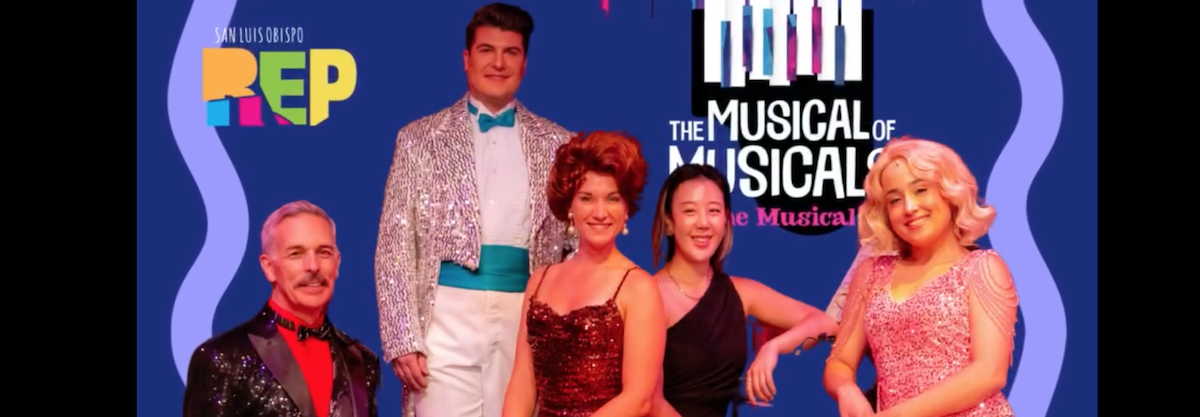Photo by Ryan Loyd, Rylo Media Design
On August 16, SLO REP opened with one heck of a show! The Musical of Musicals (The Musical!) is a hilarious comedy that parodies—you guessed it—musicals.
Written by Eric Rockwell and Joanne Bogart, this relatively new play won its first award in 2004. Yes, it’s more than 20 years old, but considering that the use of a chorus was invented by the ancient Greeks . . . it is new.
But this isn’t about the Greeks. The Musical . . . starts almost 100 years ago and spans the highlights of classic American musical theatre in a “best of”-type spoof. Think Saturday Night Live (with better actors who can sing and dance well) mockingly presenting an “Into-the-Oklahoman-Woods-with-Mame meets a Phantom-of-the-Chicago-Cabaret who’s in A-Chorus-Line,” story.
The show repeats a storyline in five different performance styles of the genre. If you like musicals, or love someone who does, and enjoy laughing at bits, puns, mockeries, sarcasm, and jabs while hearing great voices belting it out, come on down. You won’t be disappointed by this intentional imitation.
Suzy Newman, who directs this production magnificently, brings this energetic, witty history of musical theatre to life.”
The series of mini-musicals are mashups of works from various great American composers. The first act plays-within-the-play are in the styles of Rodgers & Hammerstein, Stephen Sondheim and Jerry Herman. There’s more lampooning in act two, in the styles of Andrew Lloyd Webber and Kander & Ebb, then finishes up with a little Marvin Hamlish thrown in for good measure and a kick. Puns intended.
Suzy Newman, who directs this production magnificently, brings this energetic, witty history of musical theatre to life. Every performer’s motivation, moments, and playfulness are impeccable and seamless. Nothing is wasted, even during scene changes—backstage techy Robert Frederick Taylor beautifully dances each set piece into place. This set changer, who is also billed as the assistant stage director, is as professional in his ballet performance as the main ensemble members are in their roles. Appropriately, Taylor joins the cast onstage for his bow at curtain call (and the crowd went wild opening night). Incredible!
Speaking of incredible: the entire orchestral score is played by one solitary masterful pianist on a baby grand piano upstage center. The astounding musician, Minhui Lee, and her shiny black piano are on a smoothly rotating platform representing various settings. When Lee is playing her heart out, it sometimes sounds like an actual orchestra is in the room, and she deserves a standing ovation all her own (and yes, she got one on opening night!)
Set designer Dave Linfield has done an amazing job with the dynamic, multi-use set. The rotating platform changes the style, era, and decor nearly as often as the actors change costumes. The scenes are based on the setting of each mini-musical, and Linfield’s impressive design works well despite the challenges presented by the size and shape of this theatre.
These magical theatrical elements combine to take the audience into the very heart of several eras of wonderful American musical theatre.”
The musical direction, by Lee and Lacey McNamara, is impressive and entertaining, especially when the performers alter their voices from mini-musical to mini-musical. The sometimes playful (and sometimes sinful) choreography by John Keating is spot-on for every venue and dance style depicted, as well.
Creative, sometimes humorous, and always lovely, the costumes designed by Kaila Grenz and the wigs designed by Renee Van Niel succeed in defining the various familiar characters by sight—all the while facilitating the telling of each story.
These magical theatrical elements combine to take the audience into the very heart of several eras of wonderful American musical theatre.
Last but far from least, mention should be made of the tireless performers themselves, who make it look effortless: Tim Stewart, the tenor protagonist; Edelia Oroz Westerfield, the poor soprano ingenue; Michael Tremblay, the bass antagonist; and Kelly Ann Dunn, the belting second soprano mother figure. They are individually, and as an ensemble, outstanding triple-threats: they act wonderfully, sing better, and dance until dawn, all without missing a mark.
High praise for this entire production. Don’t miss it!
Go See A Show!
